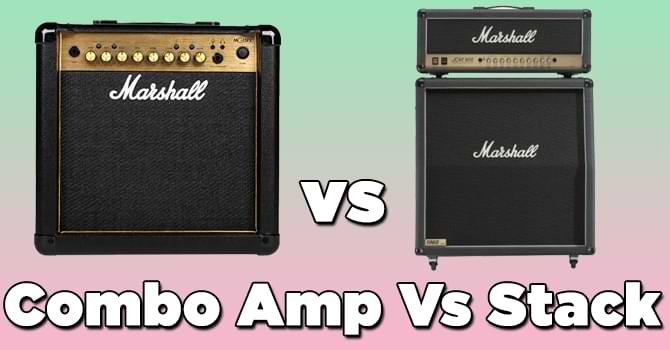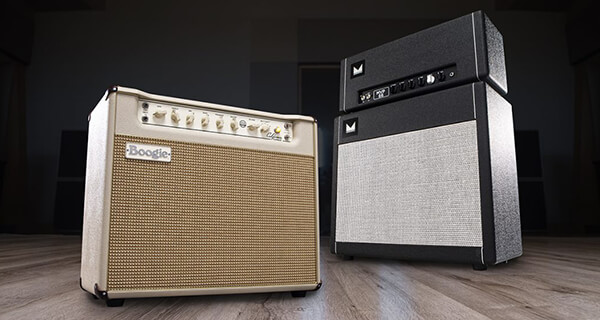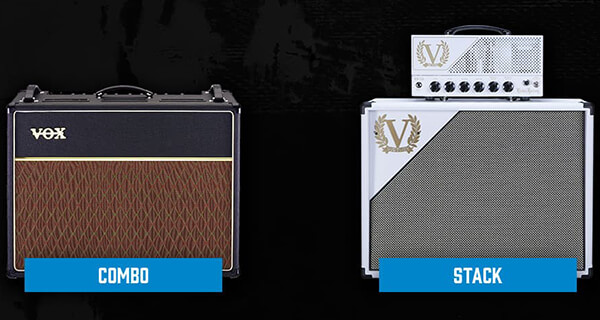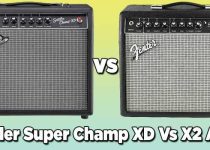Combo Amp Vs Stack [Difference & Which is better]
When it comes to crafting the perfect guitar tone and stage presence, the choice of amplifier can make all the difference. Among the numerous options available to guitarists, the debate between combo amps and amp stacks stands as one of the most enduring and impactful.
Choosing the right amplifier is crucial for guitarists, and the Combo Amp vs Stack debate is a pivotal one. In this exploration, we’ll dissect these setups, helping you make an informed decision that suits your music and practical needs.

# Table of Contents =>
Comparison Table:
| Features – | Combo Amps | Amp Stacks |
|---|---|---|
| Design | Compact, all-in-one unit with amplifier and speakers housed together | Separate components with amplifier head and separate speaker cabinet(s) |
| Portability | Highly portable, ideal for gigs and practice | Bulkier and less portable, more suitable for larger venues |
| Tonal Versatility | Limited tonal versatility, may offer fewer sound shaping options | Extensive tonal versatility, allows precise customization |
| Customization | Limited customization options | Extensive customization possibilities through component mixing |
| Ease of Use | Easy to set up and use, suitable for beginners | Complex setup and operation, may require expertise |
| Power | Generally lower power, suitable for smaller venues | High power, ideal for larger stages and venues |
| Cost | Budget-friendly options available | Can be more expensive due to multiple components |
| Tone Quality | Good for clean and moderate distortion tones | Suitable for a wide range of tones and distortion levels |
| Transportation | Convenient for travel and transportation | Requires more effort for transportation and setup |
| Genres | Suitable for various genres, especially those requiring simplicity | Versatile and ideal for genres demanding precise tonal control |
Main Difference Between The Combo Amp Vs Stack:
The main comparison between a combo amp and an amp stack revolves around their key differences in design, portability, tonal characteristics, and customization options. As well as how these factors align with the specific needs and preferences of guitarists. Here’s a concise breakdown of the primary points of comparison:
a) Design & Convenience:

Combines the amplifier head and speaker(s) in a single unit, offering a compact and portable solution. Ideal for small venues, practice, and ease of transportation. Separates the amplifier head from the speaker cabinet(s), providing more significant power and flexibility but at the cost of increased size and complexity.
b) Portability & Practicality:
Generally more portable and user-friendly, making them suitable for gigging musicians who value ease of transport and quick setup. Larger and bulkier, often requiring more effort to transport and set up, making them better suited for larger stages or permanent installations.
c) Tonal Characteristics:

May have a more limited tonal range compared to amp stacks but can still offer a variety of tones. Well-suited for players who want simplicity and versatility. Offers a broader tonal palette, allowing for precise customization of tone through separate amplifier heads and cabinets. Preferred by musicians who prioritize sonic flexibility and experimentation.
d) Customization & Expansibility:
Typically limited in terms of customization, with fewer options for adding additional cabinets or modifying the amplifier setup. Offers extensive customization possibilities, allowing players to mix and match different heads and cabinets, experiment with speaker configurations, and expand their setup for greater power and tonal variety.
Budget Considerations:
Combo amps are often a more economical choice, both for the initial purchase and ongoing maintenance. Which is making them particularly appealing to beginners and those with limited budgets. In contrast, amp stacks can represent a substantial upfront investment, especially when factoring in multiple components. Nevertheless, they may provide superior long-term value for dedicated musicians dedicated to honing their craft.
Comparison of Combo Amp vs Stack [Pros & Cons] –
| Combo Amps | Amp Stacks | |
|---|---|---|
| Pros | – Compact and portable | – High power and versatility |
| – All-in-one design | – Customizable tonal options | |
| – Easy setup and operation | – Ability to mix and match components | |
| – Budget-friendly options | – Ideal for larger stages and venues | |
| – Suitable for small venues and practice | – Can be more tonally versatile | |
| – Great for beginners and those on a budget | – Potential for expansion and added cabinets | |
| Cons | – Limited tonal range | – Bulkier and less portable |
| – Less tonal versatility | – Can be more expensive initially | |
| – May lack power for large venues | – Complex setup and transportation | |
| – Limited customization options | – Overwhelming for beginners | |
| – May struggle with extreme distortion | – Overkill for small venues |
Choosing the Right Amp for Your Genre:

Suitable for a wide range of musical genres, particularly if you prioritize simplicity and convenience. Preferred by musicians who require specific tones associated with various genres and want the ability to fine-tune their sound.
In the world of music, where sonic landscapes are painted and emotions are conveyed through the strings of a guitar. The choice between a combo amp and an amp stack is akin to selecting the artist’s brushstroke. Both options offer their unique canvases on which you can paint your musical masterpieces. But the decision ultimately hinges on your preferences and requirements.
Combo amps, with their compactness and ease of use, are the ideal companions for musicians who value simplicity, portability, and versatility. They shine in intimate settings, practice rooms, and for those who are always on the move. Combo amps may be compact, but they pack a punch and can deliver a wide range of tones to suit various musical genres and playing styles.
On the other hand, amp stacks represent the sculptor’s chisel, allowing you to carve out precisely the sound you envision. Their separation of amplifier heads and speaker cabinets provides unmatched flexibility and power. Which is making them the weapon of choice for players seeking to conquer larger stages and explore the outer limits of tonal experimentation.
As we conclude this exploration of Combo Amps vs Amp Stacks. It’s essential to remember that there is no universally “better” option. May your amplifier choice amplify not only your guitar’s sound but also the passion and creativity that flow through your music. Happy playing!
FAQs –
Question: Which is better for beginners, a combo amp, or an amp stack?
Ans: Combo amps are often recommended for beginners due to their simplicity, ease of use, and budget-friendly options. They are user-friendly and suitable for practice and small gigs.
Question: Are combo amps less powerful than amp stacks?
Ans: Generally, yes. Combo amps tend to have lower power compared to amp stacks. Amp stacks are designed for high-power output, making them better suited for larger venues and stages.
Question: Can I achieve a wide range of tones with a combo amp?
Ans: While combo amps have limitations compared to amp stacks, they can still produce a variety of tones. Many combo amps offer clean and moderate distortion tones, making them suitable for various music styles.
Question: What are the advantages of using an amp stack?
Ans: Amp stacks offer extensive customization options and high power, making them ideal for musicians who require precise tonal control and play in larger venues. They also allow you to mix and match components for unique sounds.
Question: Do amp stacks require more maintenance than combo amps?
Ans: Both combo amps and amp stacks require maintenance, but amp stacks may have more components to maintain. Routine maintenance includes cleaning, tube replacement, and speaker maintenance.
Question: Are amp stacks suitable for specific music genres?
Ans: Yes, amp stacks are versatile and can cater to various music genres. They are particularly favored by musicians who need precise tonal control and play genres demanding a wide range of tones.
Last Updated on October 13, 2023 by Perry Garner


